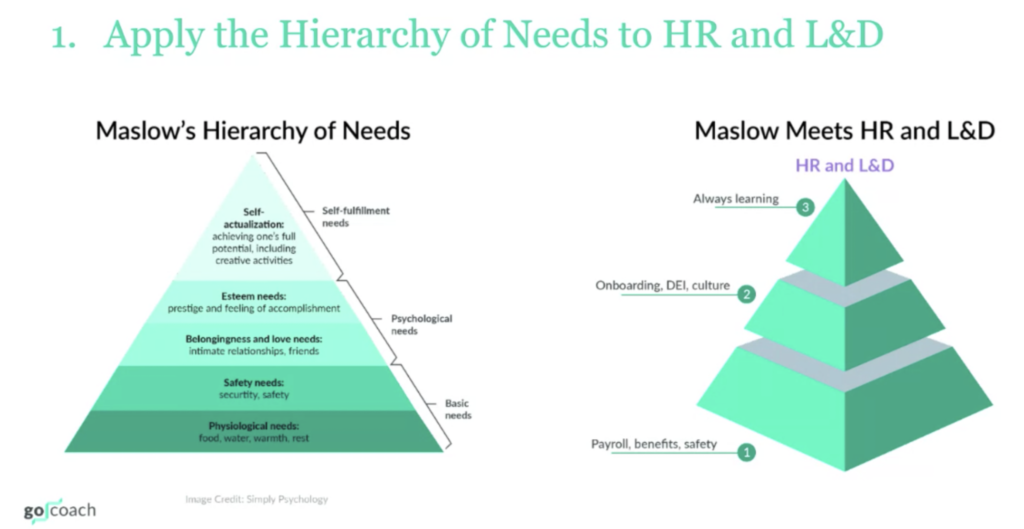10 Steps for Leading the Way to a Culture of Learning


Maslow’s Hierarchy of Needs helped change conversations around what drives people. The psychologist Abraham Maslow postulated that humans need to have physiological needs like food, shelter and safety met before they can afford to worry about psychological needs. Then comes a feeling of connection, creating community, and having a sense of esteem. Finally, the peak of Maslow’s pyramid is about finding things that feed your soul–he called it self-actualization–like exploiting innate talents and developing skills.
That hierarchy triangle can be readily adapted to HR, said Rebecca Taylor, chief operating officer and and co-founder of GoCoach, a company that helps organizations develop and implement coaching and upskilling programs. Taylor led a workshop titled “Cultural Shifts: Don’t Ride the Wave, Lead the Way to a Culture of Learning,” part of From Day One’s August virtual conference on Strategies for Communication & Collaboration in the Hybrid Workforce
At the base of the pyramid, you ensure employees’ basic needs are met–they earn a livable wage, they have what they need to get their work done, they feel safe physically and psychologically. The second layer ensures they feel valued–you have robust employee-recognition programs, you help employees develop a sense of belonging and community. And at the top, there is the development of talents and teaching new skills.
The top of that triangle can be the difference between an OK organization and a great one. It can drive engagement–Taylor’s preferred definition “the extent to which employees feel passionate about their jobs, are committed to the organization, and put discretionary effort into their work”–which in turn can reduce turnover, improve the quality of work and even increase profitability, she said. “When people feel cared for by their company and they feel a connection and kinship with the people they work with, and feel recognized for their work, then they want to see what else they can do and what they can learn to make themselves grow.”

Employee learning and development (L&D) isn’t just a feel-good initiative, said Taylor, it’s a good business practice. “Creating passion in employees doesn’t just correlate to great organizations, it creates them.” There are some truths that Taylor has learned over her 15 years of creating, implementing, and running successful learning programs, and through the creation and running of GoCoach. Here’s a top-ten list:
1.) Offer learning allowances for everyone. They can use them for conferences, classes, coaching, certification or some other method of improving their skills. “When you do that, people buy into growing their skills and developing themselves. You will see people you initially didn’t think had high potential develop to the point that you now think they do because they have the resources necessary to make that jump.”
2.) Ensure the program is flexible. Your needs may change over time. There may be challenges this year that you don’t have next year, or opportunities in 2023 that aren’t there two years later. “You need to find a vendor who can meet you where you are and help you find the right solution for you and your team.”
3.) Define what’s in it for users. “You have to give people a reason to do it,” she said.
4.) Make the program transparent and communicate about it clearly and to everyone. Repeat the information often. “People in change-management roles say it takes five to seven times of repeating something before [workers] really register it, and even more before they act on it. In a remote environment, I would argue it’s more like 15 times. If you feel like a broken record, you’re doing it right.”
5.) Even if the learning topic is the same, different audiences will have different needs. Taylor notes that in her earlier career when she delivered L&D, Taylor had to cater what she was saying to the specific group. “When you try to engage employees, think about their experience at work. What is important to them? Do they have access to a computer? Are they on the road all the time? What does their calendar look like? Will they have time to do the things you are teaching? Understand your audience and make the accommodations you can. Then you are crafting a message that resonates.”
6.) Ensure manager support and reinforcement. Managers should be able to answer basic questions that employees have about the program and provide ongoing encouragement to use the resources.

7.) The program should drive meaningful and impactful work practices, and skills that someone will use for the rest of their careers. Meaningful L&D will enhances traits and practices an employee can take to their next position in the company, not just something they can use in their current role.
8.) Identify learning champions. You can’t just roll out a program and expect it to be used. Find the people who can proselytize about the usefulness of coaching and other learning efforts. “No program has ever been successful with just one person talking about it. Partner with leaders who believe in what you are doing, especially when it comes to programs that are meant to drive employee engagement,” Taylor said.
9.) Tell them they need to follow through with this. Emphasize that while this is something you are providing to them to help them be more successful, you also have an expectation from them that they take the training seriously, participate in it, and attend any scheduled meanings.
10.) Create milestone events that go with your program. “There are trophies for sports or graduations from school. We are used to having something to show for completing certain levels of work,” she said. Create a badge to go in an email signature for completing specific training. Some companies create internal academies that, when complete, lead to company-specific certifications. Milestones can then be used as part of promotion and transfer criteria.
If you’re running programs that are driving great skills, but only in specific demographics within your organization, Taylor says you will only reap a portion of the potential benefits. But “if everyone at your company is building skills, you’ll see high levels of employee engagement, and people will feel like they matter. Employees want to be included, they want to learn, and they want to see that there is something in it for them outside of a paycheck in working for you. When you can drive learning programs that include everyone, it will lead to a good return on investment.”
Editor’s note: From Day One thanks our partner who sponsored this workshop, GoCoach.
Lisa Jaffe is a freelance writer who lives in Seattle with her son and a very needy rescue dog named Ellie Bee. She enjoys reading, long walks on the beach, and trying to get better at ceramics.
The From Day One Newsletter is a monthly roundup of articles, features, and editorials on innovative ways for companies to forge stronger relationships with their employees, customers, and communities.